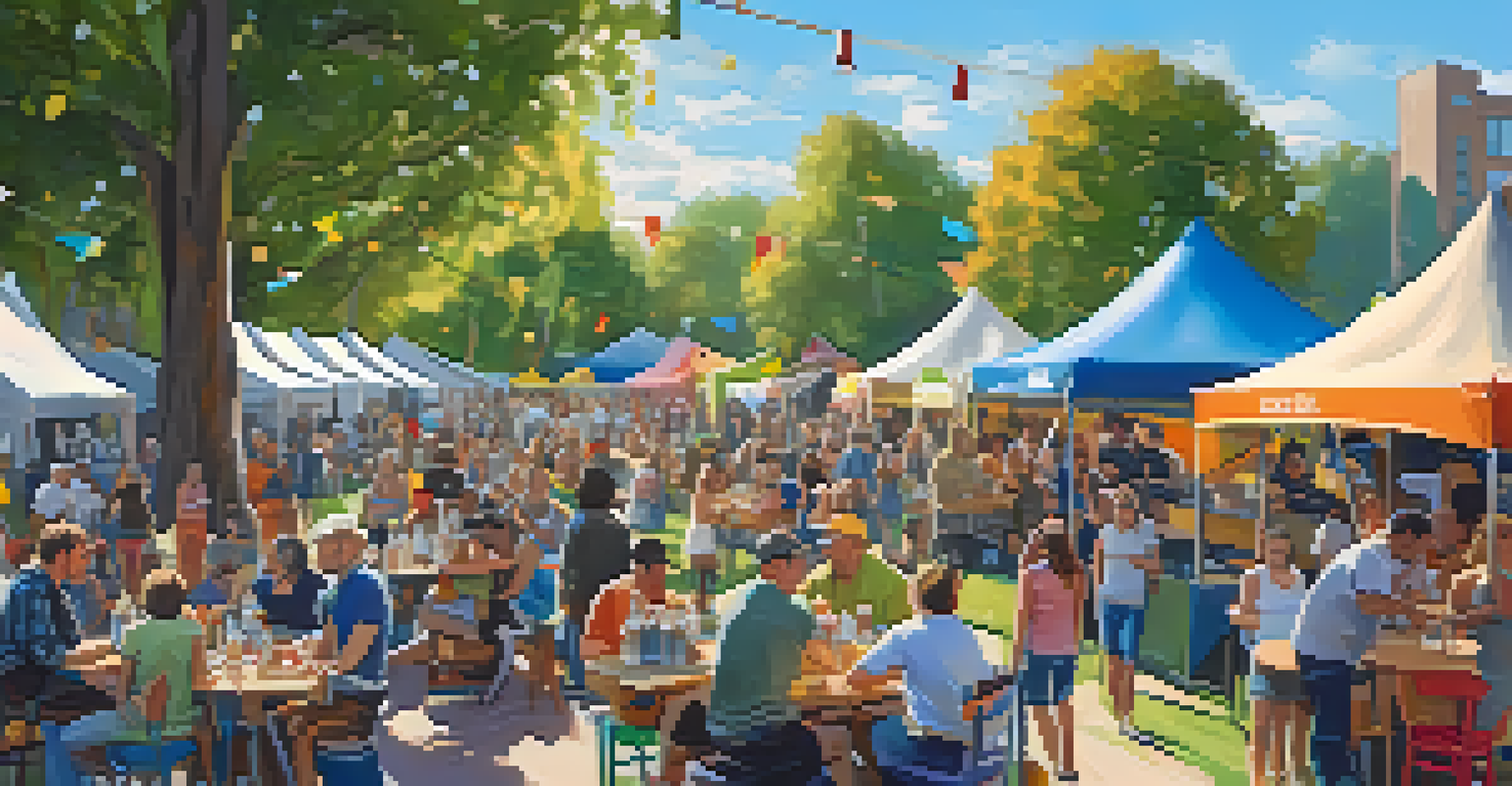The Evolution of Craft Beer: Trends Shaping the Local Scene

The Rise of Craft Beer: A Cultural Shift
Craft beer has seen a meteoric rise over the past two decades, transforming from a niche market to a cultural phenomenon. This shift reflects a growing consumer desire for unique flavors and local products, allowing small breweries to flourish. Much like the farm-to-table movement in food, craft beer emphasizes quality ingredients and artisanal brewing methods.
Good beer is a good conversation starter.
People are increasingly seeking out local breweries, where they can enjoy a pint of something made just down the street. This local focus not only supports small businesses but also fosters community connections. Just as you might choose a locally sourced tomato over a mass-produced one, many beer enthusiasts are opting for a pint that tells the story of its origins.
The love for craft beer has created a culture of experimentation among brewers. With countless styles and brewing techniques, there’s always something new to try, making each visit to a brewery an adventure. This vibrant scene encourages creativity and collaboration, resulting in unique brews that captivate both seasoned drinkers and novices alike.
Sustainability in Brewing: Eco-Friendly Practices
As awareness of environmental issues grows, many craft breweries are adopting sustainable practices. This includes everything from sourcing local ingredients to implementing energy-efficient brewing methods. Just as a garden thrives on compost, breweries are finding innovative ways to reduce waste and support the environment.

For example, some breweries are repurposing spent grain from the brewing process to create animal feed or even snacks. This not only minimizes waste but also showcases a commitment to supporting local agriculture. It’s a win-win situation that resonates with eco-conscious consumers who value sustainability.
Craft Beer: A Community Focus
Local breweries foster community connections by offering unique brews that support small businesses and engage residents.
Moreover, the trend of upcycling extends to packaging as well. Many craft breweries are choosing to use recyclable or biodegradable materials for their bottles and cans. This shift towards environmentally friendly practices reflects a broader cultural movement toward sustainability, making craft beer a choice that feels good on multiple levels.
Innovative Brewing Techniques: Pushing Boundaries
Craft brewers are constantly pushing the boundaries of traditional brewing with innovative techniques. Techniques like dry hopping and barrel-aging have become popular, allowing for the development of complex flavors. Just as a chef experiments with spices and cooking methods, brewers are finding new ways to tantalize our taste buds.
Craft beer is a bridge to our community and a way to connect with the people we love.
Additionally, many breweries are exploring new ingredients, such as exotic fruits and unusual spices, to create unique flavor profiles. This creativity keeps the beer scene fresh and exciting, encouraging drinkers to explore beyond their usual favorites. It’s much like finding a hidden gem in a bookstore—you never know what delightful surprise awaits.
The rise of technology has also played a role in this evolution. With tools that allow for precise control over fermentation and temperature, brewers can replicate and innovate with confidence. This blend of artistry and science ensures that every sip is a reflection of the brewer’s passion and expertise.
Community Engagement: Building Local Connections
Craft breweries are increasingly becoming community hubs, hosting events and fostering connections among locals. From beer tastings to festivals, these events create opportunities for people to gather and share their love of craft beer. It’s much like a neighborhood block party, where everyone comes together to celebrate local culture.
Many breweries also engage in charitable initiatives, partnering with local organizations to give back to the community. This not only strengthens community ties but also builds a loyal customer base that feels good about supporting a business with values. It’s a beautiful cycle of giving and receiving that enriches everyone involved.
Sustainability in Brewing
Many craft breweries are adopting eco-friendly practices, such as using local ingredients and recyclable packaging, to minimize their environmental impact.
Furthermore, breweries are becoming spaces for collaboration, where local artists and musicians can showcase their talents. These partnerships enhance the experience of visiting a brewery, turning it into a destination for both great beer and vibrant local culture. It’s a reminder that craft beer is not just about the drink; it’s about the people and stories behind it.
Diversity in Brewing: Expanding Flavor Profiles
One of the exciting trends in craft beer is the push for diversity in brewing styles and flavors. More breweries are embracing traditional brewing methods from different cultures, introducing unique flavors that reflect diverse backgrounds. Just as a potluck features a variety of dishes, the craft beer scene is becoming a melting pot of tastes and inspirations.
This embrace of diversity is also evident in the growing number of women and minority-owned breweries. These brewers bring fresh perspectives and innovative ideas, enriching the craft beer landscape. It’s similar to how diverse voices in literature create a richer narrative; the same applies to the world of brewing.
Events like beer festivals now often spotlight these diverse breweries, providing a platform to showcase their creations. This not only promotes inclusivity but also encourages a broader appreciation for the art of brewing. The craft beer community is learning that when we share our stories, everyone benefits.
The Role of Technology: Craft Beer and Innovation
Technology is playing an increasingly vital role in the craft beer industry, enabling brewers to innovate and streamline their processes. From mobile apps that connect consumers to their favorite local breweries to advanced brewing equipment, technology is revolutionizing the way beer is made and enjoyed. It’s akin to how smartphones have transformed our communication; the brewing world is evolving just as rapidly.
For example, many breweries are utilizing social media platforms to engage with fans, share new releases, and create buzz around events. This direct line of communication allows for a stronger connection between brewers and consumers, fostering a sense of community. It’s like having a conversation with a friend over a pint; it makes the experience more personal and engaging.
Innovation Drives Craft Beer
Brewers are continuously experimenting with techniques and ingredients, pushing the boundaries of flavor and creating exciting new beer experiences.
Additionally, the rise of e-commerce has transformed how craft beer is distributed, making it easier for consumers to discover and purchase unique brews. Many breweries now offer online ordering and delivery services, expanding their reach beyond local markets. This technological shift is paving the way for a new era of craft beer accessibility.
Future of Craft Beer: Trends to Watch
As we look ahead, several trends are poised to shape the future of craft beer. One such trend is the continued emphasis on health-conscious options, such as low-alcohol and gluten-free beers. Just as the food industry has adapted to dietary needs, breweries are also responding to consumer demands for healthier choices.
Another trend to watch is the rise of collaborative brewing, where multiple breweries come together to create unique brews. This spirit of cooperation fosters creativity and showcases the strengths of different brewers, resulting in exciting new flavors. It’s a beautiful reminder that collaboration often leads to the most innovative ideas.

Lastly, we can expect to see an increasing focus on storytelling in craft beer marketing. Breweries are likely to highlight their unique histories and the personal journeys behind their brews. Much like a good book, these stories add depth and character, making each beer more than just a drink—it becomes a narrative worth savoring.